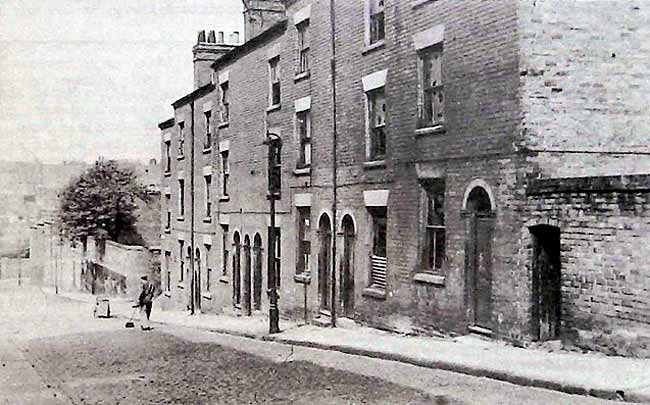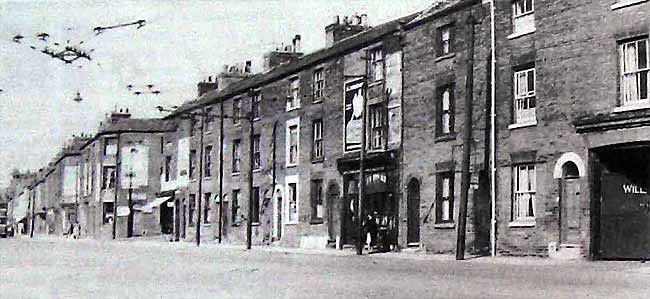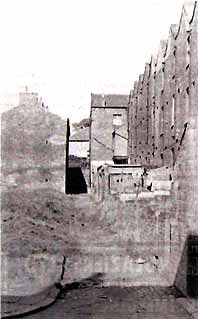< Previous
The Mysterious East:
Some childhood visits to Sneinton recalled
By Stephen Best
Despite a note to the contrary in an early issue of the 'Sneinton Magazine', I have to confess that I was not born in Sneinton. Given our family connections with the place, I have tended to regard this as an unfortunate oversight on the part of my parents. My father was born in Kingston Street, my mother lived for a time on Sneinton Boulevard, and as far back as 1851 my great-great-grandmother was resident in Pierrepont Street. In between times my grandparents had married at Sneinton Church and sundry relatives had lived at such disparate local addresses as Notintone Place and Wagstaff Yard. As a boy, though, these historical considerations were less important to me than the fact that I still had no fewer than three aunts (and two uncles) living in Sneinton, and that the closeness of our family ties meant that one or other household was visited by us every week.
These outings to Sneinton were eagerly anticipated by me. What may surprise Sneinton dwellers who look on the district as a humdrum, workaday place is that I found these journeys exciting. Living as I did in the arid sameness of Forest Fields, I thought of Sneinton as a place of romance, the mysterious east of Nottingham. Over thirty years later the ingredients which so spiced a trip to Sneinton still come easily to the mind's eye.
First of all there was the bus ride. As a family we had two ways of getting to Sneinton; one from home, one from Town, and both with their special excitements. When travelling from Forest Fields we would ride the whole way on the 44 trolleybus. I still recall the astonishment I felt about 1952 on learning that the fare for me was 2½d.; it seemed a great deal to pay, and emphasised the length of the journey. The portal of Sneinton was the end of Manvers Street, and the first feature of interest immediately presented itself in the form of the Corporation Bus Depot. Vehicles of remote vintage lurked inside the doors or stood in Stanhope Street, then roofless and exhibiting great lengths of tramline in its roadway. One great day when I was, I suppose, about six, I saw there (so memory persuades me) one of the curious single-decker trolleybuses which my mother called 'Kiddy Cars'. Beyond Stanhope Street was a shed where splendid ambulances were garaged, then came the Trent Bus Depot, and lastly, on the corner of Pennyfoot Street, a fenced area which seemed to be a kind of graveyard for redundant trolleybuses. I recall them forlornly parked, their poles down, advertising on their sides such forgotten household necessaries as Oxydol, Rinso, and Wimsol. The last was advertised as 'made to be maid', a pun which baffled me greatly. The advert featured an up-ended bottle or tin, but whether the product was intended for cleaning windows, polishing furniture, or pouring down the lavatory, I cannot say. On the left were the streets where my dad spent his childhood, with Kingston Street, his birthplace, climbing gently uphill. Whenever I asked about No. 13, the house he was born in, my father would reply, 'Never a very lucky house'. I realised when I was a bit older that he must have been thinking of the infant deaths of a brother and two sisters, the last dying at the same time as their mother, 39 years old and worn out after bearing eight children. Near the bottom of Kingston Street an archway opened on to Manvers Street. Over it was a name that seemed in 1950 merely odd, but which a few years later was to occasion unseemly mirth: 'Patent Place'.
 KINGSTON STREET IN MAY 1958, with Manvers Street at the bottom. At the corner of Beaumont Street is the wall of the Albion Chapel Yard. Nearly all the houses are empty and awaiting demolition. (All photographs by courtesy of Nottinghamshire County Local Studies Library.)
KINGSTON STREET IN MAY 1958, with Manvers Street at the bottom. At the corner of Beaumont Street is the wall of the Albion Chapel Yard. Nearly all the houses are empty and awaiting demolition. (All photographs by courtesy of Nottinghamshire County Local Studies Library.) MANVERS STREET, LOOKING NORTH from the corner of Pennyfoot Street in October 1958. The shop with the sun-blind is at the corner of Kingston Street, with the entrance to Patent Place next to it. The shop in the centre of the picture is J. Redmile, cycle repairer.
MANVERS STREET, LOOKING NORTH from the corner of Pennyfoot Street in October 1958. The shop with the sun-blind is at the corner of Kingston Street, with the entrance to Patent Place next to it. The shop in the centre of the picture is J. Redmile, cycle repairer.Just a little further along Manvers Street another Sneinton phenomenon would assert itself. This was the smell. Distance, I know, lends enchantment, and I may be thought strange now for saying that I liked the curious aroma, compounded I think of Eastcroft Gasworks and the railway yards that flanked Manvers Street. Nevertheless the smell was an important component of the Sneinton I visited, and I remember it with affection. On our left we passed the gloomy, cave-like entrance to Manvers Street goods station, where that now-vanished animal, the railway horse, was often in evidence. Immediately before reaching Sneinton Hermitage, the trolleybus went under the girder bridge which carried the goods line over the road, and it would always slow down to a little over walking pace to prevent, so it was said, the poles coming off the wires and becoming inextricably entangled with the underside of the bridge. Here we would get off if we were going to see my aunt and uncle on Manor Street. It was only a short walk from the Hermitage to 31 Manor Street, but what a walk: First came the climb, part steps and part hill, up Lees Hill Footway. How I used to envy the people who lived in the little houses (there were three of them I think) half way up. I seem to remember that the houses had front yards entirely composed of blue bricks, and wooden fences marking their boundaries. At the top, behind a fence of tarred sleepers set vertically, was the goods station, on a sort of terrace cut out of the top of the Hermitage rock. On Lees Hill Street was a fire hydrant mark at a convenient height for a small boy to climb on when his father was disinclined to lift him to look over the fence. There was usually a good deal of activity in the goods yard below, with wagons being loaded and unloaded. Only once, though, did I ever see an engine in the yard there. For years, it seemed, I had had a ritual peep over the fence, and when my persistence was at last rewarded I triumphantly told my aunt and uncle that I had seen a Jinty tank in Manvers Street Station. It is to their credit that they concealed the indifference they must have felt at this revelation, and joined in my delight. My Uncle Jim was a bus inspector and, I think, one of the best-respected men in Sneinton. A vivid part of my Sneinton memories is the picture of him setting out for work on a winter day, clad in stout boots and a sort of milkman's sleeveless leather jerkin under his uniform coat, fortified against the cold by a dose of cod liver oil and malt which my aunt spooned out of a huge tin.
If we were not visiting Manor Street, but going to my mother's sisters on Lyndhurst Road and Lichfield Road, we stayed on the trolleybus as far as Baden Powell Road. Just before we got off, another attraction manifested itself in the shape of a ruined church: St. Christopher's had been bombed in 1941 and was not rebuilt until 1952.
My parents could not have been expected to share my youthful enthusiasm for its burnt-out windows and jagged roofline, as they had been married there in 1935, and I dimly remember going with them to a service in the ruins, with my brother in a pushchair. Beyond the bus stop a high arched bridge carried the disused suburban line over Colwick Road. This bridge was made all the more mysterious and intriguing by the row of silent goods wagons and vans stored on it, never moving, so it seemed, for years on end. There was a dark rumour that these vehicles had been shunted on to the line here to divert the Luftwaffe from lines that were of strategic importance, and the fact that Sneinton was hit in the Nottingham air-raid of May 1941 lent credence to this canard. There was of course no truth in the tale, but I don't think that my aunts were ever convinced. The walk from Colwick Road to Lyndhurst Road and Lichfield Road had nothing as dramatic as Lees Hill Footway, but there were a couple of minor attractions. Next door to my aunt's house on Lyndhurst Road was a shop, but a shop unlike any other I had seen. It was just an ordinary terrace house with a (very slightly) enlarged window, into this I would peer at what seems, at this remove, to have been a profusion of sweets in jars, soap, scrubbing brushes and clothes-lines. On the way to Lichfield Road we would occasionally visit an acquaintance (I forget whom) on Taylor Close. To an envious seven-year old the residents of Taylor Close were as privileged as the denizens of Lees Hill Footway. Both places were high up, with only a path outside the front door instead of a road, and both had a railway at hand, for at the end of the Taylor Close gardens was another glimpse of the Suburban Line; here it ran in a cutting, and you could look down on the row of derelict wagons.
During my later boyhood years, if ever we arrived at my Lichfield Road aunt's in the evening, her house would be graced by cars parked outside. These were not family vehicles (such conveyances did not exist), but belonged to the patrons of a mysterious institution called the Wembley Club, which lay at the corner of Sneinton Dale. Social clubs, then as now, were to me a closed world, and I had no idea of what went on there. According to my aunt, though, the chief pleasure of its customers reposed in the slamming of car doors below her bedroom window just as she and my uncle were drifting into sleep.
 THE REMAINS OF TEN FEET STREET from Sneinton Road, September 1958. On the right are backs of houses in Notintone Place, and on the left are derelict houses on Camden Street.
THE REMAINS OF TEN FEET STREET from Sneinton Road, September 1958. On the right are backs of houses in Notintone Place, and on the left are derelict houses on Camden Street.When we travelled to Sneinton from the City centre, we would usually come by the number 3 bus. This may have been in response to my pleas, for, living in Forest Fields, we were served only by trolleybuses, and the chance of riding in what we called a 'petrol bus' was not to be missed. I would always try to sit behind the driver, gazing through the glass panel as he performed strange operations like changing gear, and was inconsolable when the concertina-like blind at his back was down. The number 3 route perhaps lacked the grandeur of the 44 journey, but was nonetheless full of incident. The Sneinton interest began when the bus swung into Sneinton Road and stopped outside what had unmistakeably once been a cinema. Although for most of my childhood occupied by a firm of furnishers, the old Sneinton Picture Palace was impossible to disguise. It comes as something as a shock to look back and realise just how much of a rarity a disused cinema was then, and I suppose that is why it caught my imagination so strongly. Nottingham could not receive television pictures until the Sutton Coldfield transmitter was operational in 1949, and no one envisaged the devastating effect that television would have on Nottingham's cinemas. As it did not finally close down until December 1945, I must have passed the Palace while it was still a cinema, but I recall it only as Spencer's or Leyland Office Furniture. The Palace stood where Byron Court stands now, and not far distant, half way up Sneinton Road on the left, was a row of fine, tall houses set back with their front gardens on top of what I supposed were once stables or storehouses. The one that stuck in my mind bore the plate (stone I think, not brass) of Mr. Sissons the dentist. Opposite, the Albion Chapel stood at the junction of three streets, dwarfing the houses round it. One of these, on the corner of Beaumont Street, was a shop with splendid window shutters. I remember that it turned the corner with an elegant curved profile, rather than the everyday right angle I was used to. As we passed the Albion my father used to tell me about the time one of his brothers got into trouble by running round the parapet on the roof of the Chapel with a youthful local desperado named Ambrose. I imagine that if you were a lad in Edwardian Sneinton and your name was Ambrose you just had to be rough. At the top of Sneinton Road, just above a pub called the Paul Pry, Notintone Place ran off to the left. What impressed me most were the big trees in its gardens, and Ten Feet Street, the narrow alley that ran behind the houses and gave access to their tall, grim backs enclosed by brick walls.
I was always glad when the bus had gone past Sneinton Church; my childish imagination was attracted by the table tombs in the churchyard, and I had the notion that people were buried above ground, within the tomb-chests. When, from time to time, some of the stone slabs cracked, I would hardly dare to look, but of course I did peep, and looked hurriedly away imagining I don't know what. A tree root or a fallen branch glimpsed in the half-light furnished plenty of material for a child's mind to get to work on. As we passed the Fox the bus would pick up speed, and tilting to what seemed an alarming angle, would race down to the Dale along that curved bit of road between Sneinton Hollows and Victoria Avenue. The road was narrower then, with shops and a garage on the south side, and an extra house at the end of Victoria Avenue which was chopped off sometime in the 1950s. The windmill made comparatively little impact on me, tucked away as it was behind the houses on Belvoir Terrace. When it was gutted by fire in 1947 I was eight and my only regret was that I had missed all the excitement. Once, and only once, did I venture up to the mill. I was then about 13 and a nervous and law-abiding boy, convinced at every step that some figure of authority would appear and order me off. The mill's burnt-out shell was, to be honest, not very eloquent or thrilling, but my recollection is that the plaque to George Green was still there.
At the corner of Trent Road St. Philip's Vicarage presented its mysterious and rambling back to the road. Its state apartments, behind a high brick wall, looked out on to a big garden, now the Jester car park. I had seen Mr. Goulton, the vicar, when my cousin was married at St. Philip's, and had been told that he had been vicar there since 1914, a year which seemed impossibly remote. Thereafter I kept an eager eye on the Vicarage in the hope of catching another glimpse of his venerable figure. A few yards away, at the bottom of Dale Grove, a sort of coal yard marked the place where another bomb had fallen: in the late 1940s Sneinton seemed to me to have borne the very brunt of the blitz. Finally, when we got off the bus and looked up Sneinton Dale past the Dale Cinema, our view was closed by another railway bridge. This one did not cross the road in a single graceful span like the Colwick Road bridge, but planted its central pier in the middle of the road, much to the annoyance of drivers. This pier was marked by a large round white target, on either side of which the traffic swerved slightly to negotiate the two arches. Buses had to take care to go through the dead centre of each arch to avoid embarrassing contact with the masonry.
As a boy it never occurred to me to wonder what lay beyond this bridge. Silent and sinister with its line of dead wagons it was for me the far boundary of Sneinton. It may be that this was the earliest manifestation in me of a mania that has never been far away. All my life I have been unable, or unwilling, to see any further than a railway.
My Sneinton aunts and uncles are dead now, but I look back with love on them all. It is, I think, a tribute to the hospitality we enjoyed at their homes that our journeys to see them gave me so much fun and happiness. I just could not have derived such pleasure from visiting people I did not like. I thank my friend George Roberts for taking the photographs in 1958 and for printing them for me twenty five years later.
STEPHEN BEST
< Previous
